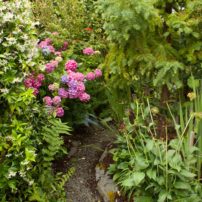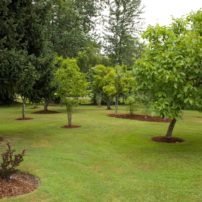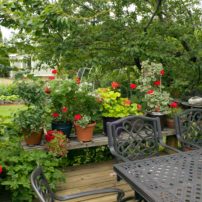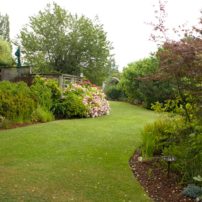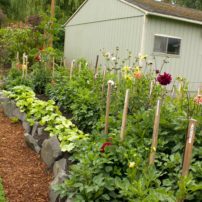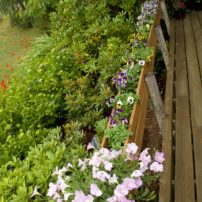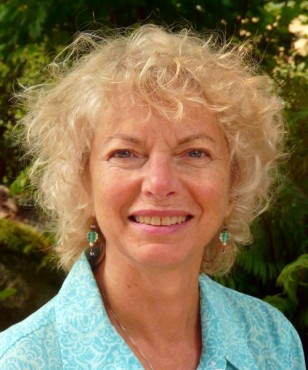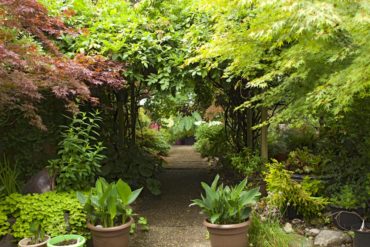 A gravel lane heads arrow-straight through a dull flood plain west toward Dyes Inlet. But turn left off the lane into the driveway of Ron Gillespie and Joyce Merkel, and you find a profoundly different world.
A gravel lane heads arrow-straight through a dull flood plain west toward Dyes Inlet. But turn left off the lane into the driveway of Ron Gillespie and Joyce Merkel, and you find a profoundly different world.
Strolling under a broad arbor dripping with masses of white and purple wisteria, ferns feathering your path, you enter a garden rich with soothing sounds of flowing water, tranquil places to relax in shade or sun, heaps of color, fascinating foliage, rare and quirky plants, and plants abundant with edibles.
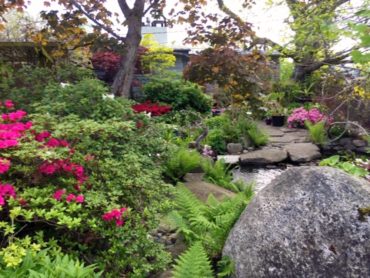 But more than that, this is a garden that seems to get updated almost as often as computer software. Gillespie is a gardener who does not “rest on his laurels,” so to speak. He has been gardening his 1.3 acres, half of that very wetland, since 1970, and is still constantly adding and deleting plants, expanding and improving.
But more than that, this is a garden that seems to get updated almost as often as computer software. Gillespie is a gardener who does not “rest on his laurels,” so to speak. He has been gardening his 1.3 acres, half of that very wetland, since 1970, and is still constantly adding and deleting plants, expanding and improving.
In the front garden, under tall trees and amid shrubs, a waterfall flows from an antique hand pump down a shallow series of flat rocks into a small pool. Very long ago, this old hand pump actually pumped water at Gillespie’s grandfather’s property in Yelm. Two weathered, wooden chairs sit on a small patio facing the waterfall. Gillespie said this is their favorite place to rest on a summer afternoon, shaded from the western sun. Small gold fish swim among water lilies in the fern-fringed pool. Birds come to drink and bathe in the shallow stream.
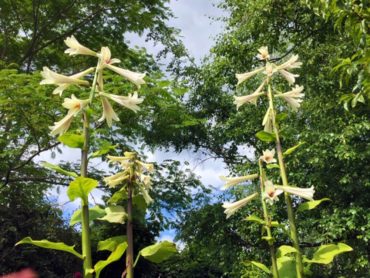 On the far side of the pool, a pair of dwarf, weeping, red-leaf Japanese maples and an old stone lantern sit near the base of a nearly 10,000-pound, mountain-shaped boulder, thick with moss. Together, these elements create the illusion of a distant landscape across a lake.
On the far side of the pool, a pair of dwarf, weeping, red-leaf Japanese maples and an old stone lantern sit near the base of a nearly 10,000-pound, mountain-shaped boulder, thick with moss. Together, these elements create the illusion of a distant landscape across a lake.
“It’s a real calming place. You almost catch yourself relaxing,” Gillespie said with a laugh.
Under a canopy of Norwegian red oak, aspen and maples, flowers and foliage provide color, changing through the seasons. Fragrant sarcococca blooms by the front door in December and January.
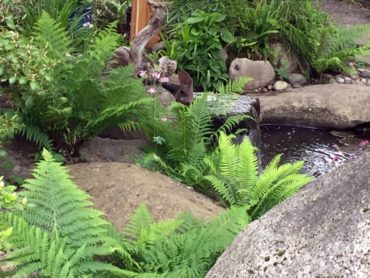 The next to blossom are the trilliums.
The next to blossom are the trilliums.
“It’s the first thing, when winter is over,” said Merkel, “and you feel spring is going to be here.”
Later, deep-purple rhododendron and pink-and-white azaleas blaze. Then a crepe myrtle leafs out in brilliant bronze leaves, and a ‘Limelight’ hydrangea adds sunny, lime-gold foliage.
Summer brings false Solomon seal, hostas and deep-purple clematis, while a handkerchief tree (Davidia) waves its big, white, hanky-like bracts. The peely red bark of a low-growing manzanita and twisty skeleton of a contorted hazelnut add architectural interest year-round.
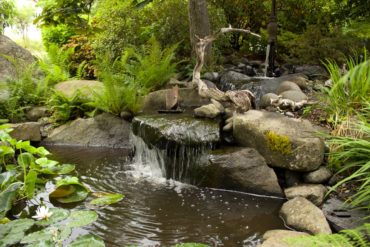 Gillespie has always had a penchant for peculiar plants. A few of those in this shady front garden include giant-leaved gunnera, some tall carnivorous plants and a rare hybrid Hydrangea x dichroa with small, purple flowers.
Gillespie has always had a penchant for peculiar plants. A few of those in this shady front garden include giant-leaved gunnera, some tall carnivorous plants and a rare hybrid Hydrangea x dichroa with small, purple flowers.
But the largest concentration of unusual plants grows in the section Gillespie calls the Seuss garden. This garden has also evolved over time. Some plants were edited out. Even more plants with big leaves and exotic form and flowers have been added.
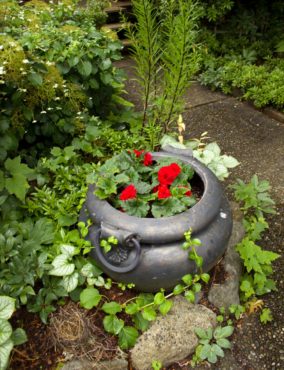 Some of those rare plants are Olearia cheesemanii, an evergreen shrub with white flowers that smell like coconut; another evergreen shrub called Daphneiphyllum macropodum, described on its plant tag as “tough as a street thug, brutally handsome”; and Viburnum cylindricum, striking for its blue berries on pink pedicels.
Some of those rare plants are Olearia cheesemanii, an evergreen shrub with white flowers that smell like coconut; another evergreen shrub called Daphneiphyllum macropodum, described on its plant tag as “tough as a street thug, brutally handsome”; and Viburnum cylindricum, striking for its blue berries on pink pedicels.
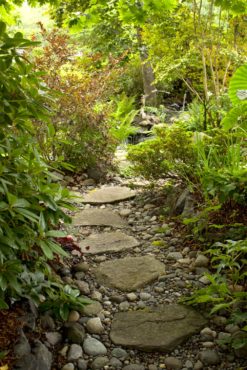 Gillespie’s fondness for fantastically big foliage finds full expression in the Seuss garden, beginning with the two very tall fig trees at the entrance. In addition, schefflera, rheum, Crambe cordifolia, mayapple (Podophyllum peltatum) and Himalayan cobra lily (Arisaema consanguineum) all thrive in this somewhat jungle-like garden, as well as hostas, rodgersia and acanthus.
Gillespie’s fondness for fantastically big foliage finds full expression in the Seuss garden, beginning with the two very tall fig trees at the entrance. In addition, schefflera, rheum, Crambe cordifolia, mayapple (Podophyllum peltatum) and Himalayan cobra lily (Arisaema consanguineum) all thrive in this somewhat jungle-like garden, as well as hostas, rodgersia and acanthus.
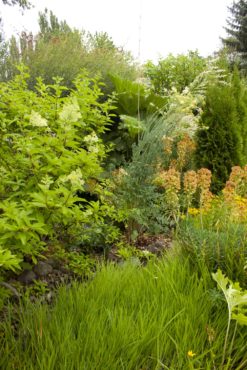 But the Seuss garden is not just about big leaves. Corokia’s teeny-tiny leaves, feathery leaves of sophora and meadow rue (Thalictrum), and spiky sea holly (Eryngium) add textural contrast. And bold splashes of color are provided by tall, deep-purple-pink lilies; peonies; dark-red calla lilies; alliums; phlox and foxtail lilies, to name just a few of the flowering plants.
But the Seuss garden is not just about big leaves. Corokia’s teeny-tiny leaves, feathery leaves of sophora and meadow rue (Thalictrum), and spiky sea holly (Eryngium) add textural contrast. And bold splashes of color are provided by tall, deep-purple-pink lilies; peonies; dark-red calla lilies; alliums; phlox and foxtail lilies, to name just a few of the flowering plants.
“The part that just amazes me is how these things are growing up and how everything is fitting together,” Gillespie said.
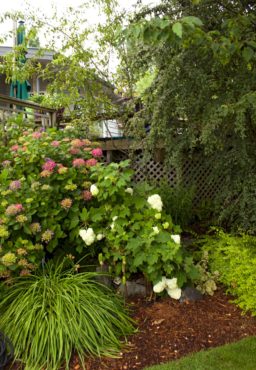 Near the Seuss garden is an extensive rain garden that Gillespie installed a number of years ago. Rushes and Japanese forest grass, red and yellow twig dogwoods, several types of willow and giant gunnera all thrive here. Recently, Gillespie expanded the edges of the rain garden out another 6 to 8 feet wider, because — well, there are always new plants. Among the plants he has added to this higher, somewhat dryer edge are witch hazel, hardy hibiscus, schefflera, Roscoeae ‘Family Jewels’ (with flowers resembling orchids), echinacea and agastache.
Near the Seuss garden is an extensive rain garden that Gillespie installed a number of years ago. Rushes and Japanese forest grass, red and yellow twig dogwoods, several types of willow and giant gunnera all thrive here. Recently, Gillespie expanded the edges of the rain garden out another 6 to 8 feet wider, because — well, there are always new plants. Among the plants he has added to this higher, somewhat dryer edge are witch hazel, hardy hibiscus, schefflera, Roscoeae ‘Family Jewels’ (with flowers resembling orchids), echinacea and agastache.
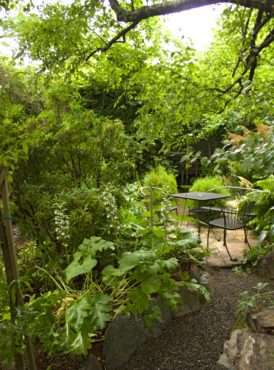
On the sunny west and south sides of the house there are masses of color. A wide bank of rhododendrons and azaleas in spring yields to deep-pink and blue mophead hydrangeas and huge, white-to-pink cones of Vanilla Strawberry and Pinky Winky panicle hydrangeas in summer.
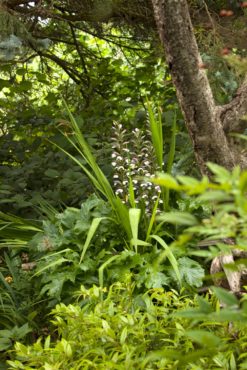 Along the south property line, Gillespie built a tall, very open, lattice-like fence to allow light through and to provide support for three kinds of climbing hydrangeas and lilies that reach almost 7 feet tall. In summer, dahlias of all sizes put on a brilliant display in yellow, red, melon, pink, palest lavender, white and dazzling mixtures of colors.
Along the south property line, Gillespie built a tall, very open, lattice-like fence to allow light through and to provide support for three kinds of climbing hydrangeas and lilies that reach almost 7 feet tall. In summer, dahlias of all sizes put on a brilliant display in yellow, red, melon, pink, palest lavender, white and dazzling mixtures of colors.
Between this south border and the house, lots of edibles grow in an intensively planted area that Gillespie and Merkel call the Mediterranean garden. Closest to the back door, thyme, marjoram and other herbs thrive. In raised beds, they grow cardoons, rhubarb, artichokes, asparagus, snap peas, collards, chard, tomatoes, strawberries, raspberries and more.
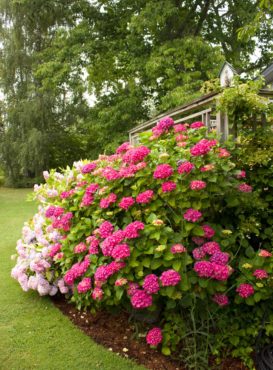 Nearby, a big blueberry patch, enclosed with a netted structure to keep birds out, produces gallons of sweet, succulent berries. Fruiting red currants also thrive.
Nearby, a big blueberry patch, enclosed with a netted structure to keep birds out, produces gallons of sweet, succulent berries. Fruiting red currants also thrive.
“We make jelly from the juice,” Merkel said.
In addition, there is an olive tree, more fig trees and peach trees. The peach branches hang over the deck.
“That’s my favorite,” she said. “I can sit on the deck and pick my peach and eat it.”
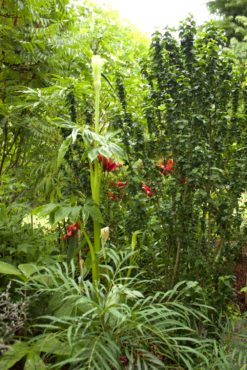 A large grape arbor adjacent to the back of the house not only produces grapes, but also provides shade for a spacious patio with several tables and chairs.
A large grape arbor adjacent to the back of the house not only produces grapes, but also provides shade for a spacious patio with several tables and chairs.
“This is our entertainment area,” Merkel said. “We’ve had a lot of functions here.”
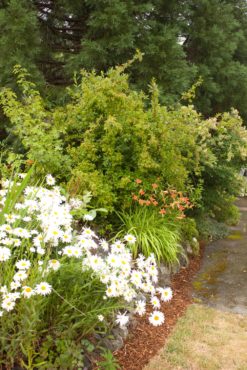 East of the grape arbor and along the east edge of the Mediterranean garden, where the trees have grown taller, creating more shade, and the ground is wetter, Gillespie and Merkel have been revising the plantings lately. Some of the newer plants along here include a giant reed that is 7 to 8 feet tall, some clumping bamboo, a Chinese plum yew (Cephalotaxus fortunei), vine maple, astilbe, goat’s beard, phlomis and gigantic Himalayan lily that’s grown as tall as 13 feet, 1 inch.
East of the grape arbor and along the east edge of the Mediterranean garden, where the trees have grown taller, creating more shade, and the ground is wetter, Gillespie and Merkel have been revising the plantings lately. Some of the newer plants along here include a giant reed that is 7 to 8 feet tall, some clumping bamboo, a Chinese plum yew (Cephalotaxus fortunei), vine maple, astilbe, goat’s beard, phlomis and gigantic Himalayan lily that’s grown as tall as 13 feet, 1 inch.
In a small, cozy spot in this part of the garden, they have installed a patio of pavers, just big enough for a little table and a pair of chairs. Planted around the patio are maidenhair ferns, bright-yellow oxeye daisies, mini “mouse ear” hostas, mondo grass, autumn ferns and false Solomon’s seal. This partly shaded garden room feels especially inviting and restful.
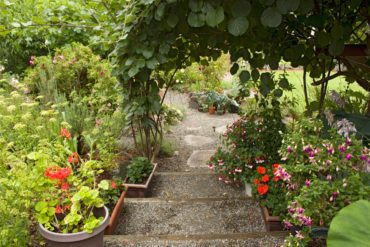 Another work-in-progress is a new shade garden in the narrow breezeway between the east side of the house and the garage. Under a vine maple and a new arbor, the couple recently planted several varieties of hostas and ferns.
Another work-in-progress is a new shade garden in the narrow breezeway between the east side of the house and the garage. Under a vine maple and a new arbor, the couple recently planted several varieties of hostas and ferns.
East of the garage, the ground is very wet all the way to the main road. This area has the appearance of a park, with mown grass and widely spaced, many-decades-old weeping willows.
“I planted all of these trees here, mostly from twigs,” Gillespie said.
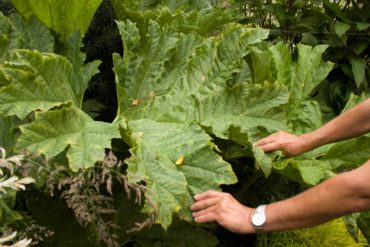 Closer to the gravel drive is the orchard. It has several kinds of apple and pear trees, one of which Gillespie planted 45 or 50 years ago. There are some luscious, big blueberries here also. All of these require regular pruning and, of course, harvesting.
Closer to the gravel drive is the orchard. It has several kinds of apple and pear trees, one of which Gillespie planted 45 or 50 years ago. There are some luscious, big blueberries here also. All of these require regular pruning and, of course, harvesting.
But it’s not all work. Gillespie and Merkel do manage to find time to simply rest and enjoy the fruits of their labor. Gillespie has been known to hang his hammock in the deep shade under the grape arbor, which Merkel calls his “man-cave.”
And about the new, cozy shade patio, Merkel said, “We come out here with a glass of tea or beer when we’re tired.”




